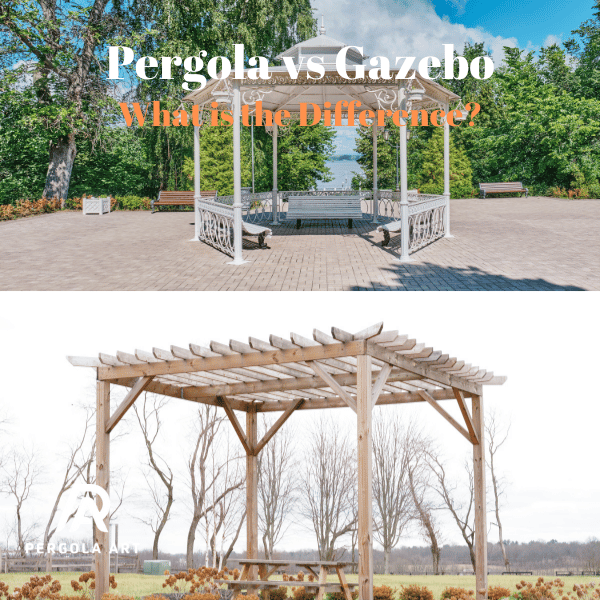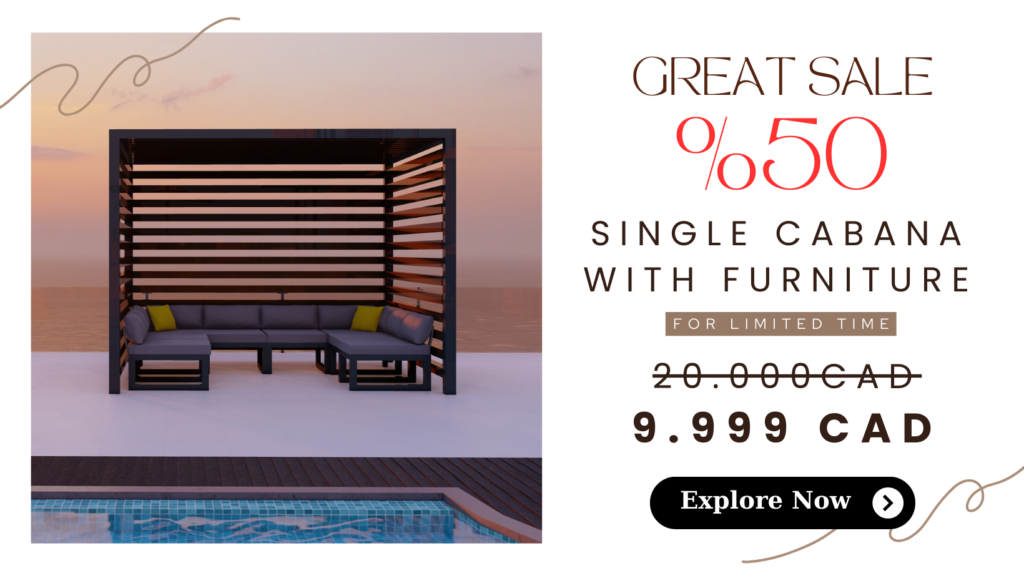Did you know that 53% of Canadians who have a yard prefer to use their outdoor space for lounging and relaxing? Well, we aren’t surprised.
It’s only natural to disconnect from the digital world and relax in the evening after returning from work or school. And people who don’t have a yard in their homes resort to going to outdoor cafes and coffee shops to relax and spend their evenings with their friends and family.
Pergolas and Gazebos are iconic structures to create a space for relaxation and lounging in your outdoor space. They are a great structure which can be decorated according to your taste. But what is the difference between a pergola vs gazebo? Are they the same thing or different? And which one should you get?
Don’t worry, let’s break it down for you in this article:
3 Major Differences Between Pergola vs Gazebo
Even though both the pergola and gazebo are almost (emphasis on almost) similar structures, they have many differences that make them unique.
1. Structure and Design
Pergolas are known for their open and airy design, with a lattice roof that can be covered but is mostly uncovered.
Explore: Types of Pergola
On the other hand, gazebos have a closed roof structure that provides complete shade and typically comes in an octagon shape.
2. Functionality
Both the pergola and gazebo are functional. A pergola is more suitable for outdoor dining and gardening or as a stylish passageway from your home to your garden and through to the driveway.
Gazebos create a distinct outdoor room, ideal for sheltered entertainment, meditation, or even a barn.
3. Roof
The main difference between a pergola and a gazebo is the roof.
A pergola’s roof is made of flat horizontal slats that can have retractable cover, but that’s an optional additional thing.
A gazebo has a solid roof which is shaped like a cone. This cone shape allows for any additional water and snow to just slide through the gazebo’s roof.
Difference Between Pergolas & Other Structures
Gazebo is not the only opponent of pergola. There are many other structures from the same family which serve different purposes in different settings.
Need to Know: What is a Pergola?
Some of these structures are:
- Arbor
- Pagoda
- Awning
- Cabana
- Canopy
- Pavilion
Arbor vs Pergola
Both arbors and pergolas have open structures, but an arbor is typically used as an entryway or accent within a garden and is often covered in climbing plants. It’s smaller than a pergola and usually consists of two or four posts with a simple slatted roof.
Pergolas are larger and can cover more extensive areas like patios, decks, or entire walkways. And don’t have to be covered with plants.
Pavilion vs Pergola
Both of these structures are very similar to each other. Pavilions have a fully enclosed roof that offers complete shelter from rain, sun, and snow.
Pergolas, with their slatted roofs, provide partial shade while still allowing light, rain, and snow through.
Cabana vs Pergola
Cabanas are enclosed on three sides with a roof overhead and are mainly used for privacy and protection. They’re often found next to pools or on beaches, serving as changing areas or shaded picnics.
Pergolas are open on all sides and are ideal for garden integration or as an architectural feature to enhance outdoor living areas.
Awning Vs Pergola
Awnings are attached to the exterior of a building and can be extended or retracted to provide shade or protection from the weather directly over windows, doors, or patios. They’re typically made of fabric and metal and offer more flexibility.
Pergolas are stationary structures that create a permanent shaded area in your garden or outdoor space, providing a fixed amount of shade.
Pergola vs Gazebo: Which Is Better?
Which option is better? Pergola or Gazebo?
Well, it depends entirely on your lifestyle, garden size, and aesthetic preference. If you are a nature-lover and have an openness for natural elements like plants, rain, storms, and snow, then a pergola is a good option for you because it complements the landscape while providing an outdoor space.
If you’re looking for a cosy, sheltered spot to enjoy the outdoors regardless of the weather, a gazebo could be the right fit, which offers a more intimate setting for relaxation and entertainment.
Homeowners tend to use pergolas because it is affordable and merges with the architecture, while cafes, bars and restaurants tend to use gazebo more to protect their guests from unexpected weather. What about other pergola ideas?
Beautify Your Outdoor Space In Canada
Both the gazebo and pergola can enhance your outdoor space by providing beauty and functionality. Statistics show that 9 out of 10 Canadians have a yard. So, If you’re a homeowner, you can enjoy some outdoor time with family or enjoy some me-time in nature. And if you’re a restaurant owner, then adding a gazebo or pergola can help you attract more customers and use the full potential of your space.
When you hire Pergola Art (pergola manufacturer in Canada) to install a gazebo or pergola in your space, you should be sure that we will be considering your personal style, the functional needs of your family, and the characteristics of your landscape, and select the structure that best suits your home or commercial property.
FAQs About The Difference Between Pergola and Gazebo
Are pergolas or gazebos better?
Neither is objectively better; it depends on your needs and preferences. Pergolas are ideal for those who love an open and airy feel, while gazebos suit those seeking more shelter and privacy.
Which is more expensive: gazebo or pergola?
Gazebos are more expensive than pergolas because of their intricate design and the additional materials required for the closed roof and often more elaborate construction. But, the cost can vary based on size, materials, and customization.
Do you need permission to build a pergola?
It depends on your local state regulations. Typically, smaller structures don’t need permits, but it’s always best to check with local authorities to ensure compliance with all building codes and regulations.
Good to Know: How to Build a Pergola?



